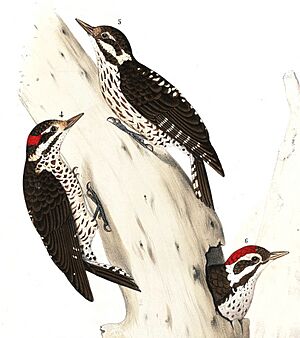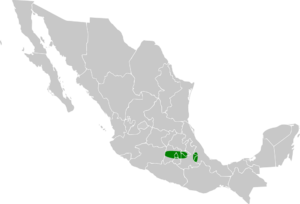Strickland's woodpecker facts for kids
Quick facts for kids Strickland's woodpecker |
|
|---|---|
 |
|
| Conservation status | |
| Scientific classification | |
| Genus: |
Leuconotopicus
|
| Species: |
stricklandi
|
 |
|
| Synonyms | |
|
Picoides stricklandi |
|
The Strickland's woodpecker (Leuconotopicus stricklandi) is a medium-sized bird. It is a type of woodpecker found only in Mexico. The Arizona woodpecker used to be considered the same species. However, experts decided they were different birds. Now, they are two separate species.
Contents
All About Strickland's Woodpeckers
This section will tell you more about the Strickland's woodpecker. You will learn what it looks like. You will also find out where it lives.
What Does a Strickland's Woodpecker Look Like?
Strickland's woodpeckers are about 7 to 8 inches long. That is about the length of a pencil. They are mostly brown and white. Their upper body is brown, with a dark area near their tail. Their belly is white with many small brown spots.
These birds have three white stripes on their wings. They also have two white stripes on their face. These stripes connect to another white stripe on their neck. Male woodpeckers have a red patch on the back of their head. Female woodpeckers do not have this red patch.
Where Do Strickland's Woodpeckers Live?
Strickland's woodpeckers are quiet birds. They are a bit shy. You can find them in certain parts of Mexico. They like to live in pine forests. They also live in areas with both pine and oak trees. These areas are usually high up, between 4,500 and 7,000 feet. This is like living on a tall mountain. Their home range is a narrow band across central Mexico. It stretches from Michoacán to Veracruz.
How Do Strickland's Woodpeckers Reproduce?
Strickland's woodpeckers make their nests in dead trees. They dig a hole in the tree trunk. The female bird lays three to four white eggs inside. She places the eggs on a bed of wood chips. We do not know much about how long they nest. We also do not know much about when they lay eggs.
Images for kids




